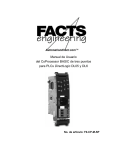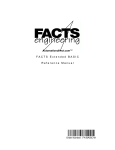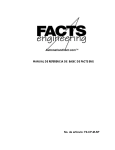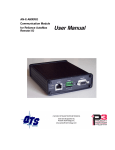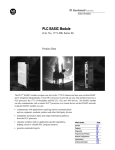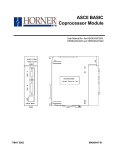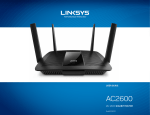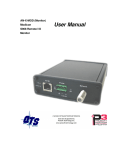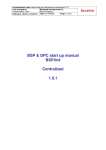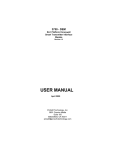Download Automationdirect.com™ D i r e c t L o g i c 2 0 5 T r i p l e P o r t
Transcript
Automationdirect.com
Direct Logic 205
Triple Port BASIC CoProcessor
F2-CP128
Order Number: F2-CP-M
TRADEMARKS
Automationdirect.com is a Trademark of Automationdirect.com
CoProcessor is a Trademark of FACTS Engineering, Inc.
COPYRIGHT
Copyright 1994, FACTS Engineering Inc., 8049 Photonics Dr., New Port Richey, Florida,
34655.. World rights reserved. No part of this publication may be stored in a retrieval
system, transmitted, or reproduced in any way, including but not limited to photocopy
photograph, magnetic or other recording media, without the prior agreement and written
permission of FACTS Engineering, Inc.
Last Issued Date: May 1999
Current Issued Date: October 2007
WARNING
Thank you for purchasing automation equipment from FACTS Engineering. We want your
new FACTS Engineering automation equipment to operate safely. Anyone who installs or
uses this equipment should read this publication (and any other relevant publications)
before installing or operating the equipment.
To minimize the risk of potential safety problems, you should follow all applicable local and
national codes that regulate the installation and operation of your equipment. These codes
vary from area to area and usually change with time. It is your responsibility to determine
which codes should be followed, and to verify that the equipment, installation, and
operation is in compliance with the latest revision of these codes.
At a minimum, you should follow all applicable sections of the National Fire Code, National
Electrical Code, and the codes of the National Electrical Manufacturers Association
(NEMA). There may be local regulatory or government offices that can help determine
which codes and standards are necessary for safe installation and operation.
Equipment damage or serious injury to personnel can result from the failure to follow all
applicable codes and standards. We do not guarantee the products described in this
publication are suitable for your particular application, nor do we assume any responsibility
for your product design, installation, or operation.
If you have any questions concerning the installation or operation of this equipment, or if
you need additional information, please call us at 1-800-783-3225.
This document is based on information available at the time of its publication. While efforts
have been made to be accurate, the information contained herein does not purport to cover
all details or variations in hardware and software, nor to provide for every possible
contingency in connection with installation, operation, and maintenance. Features may be
described herein which are not present in all hardware and software systems. FACTS
Engineering assumes no obligation of notice to holders of this document with respect to
changes subsequently made. FACTS Engineering retains the
right to make changes to hardware and software at any time, without notice. FACTS
Engineering makes no representation or warranty, expressed, implied, or statutory with
respect to, and assumes no responsibility for the accuracy, completeness, sufficiency, or
usefulness of the information contained herein. No warranties of merchantability of fitness
for purpose shall apply.
MANUAL HISTORY
Refer to to this history in all correspondence and/or discussion of this manual.
Title: 205 CoProcessors User’s Manual
Part Number F2-CP-M
Issue / Date
First 5/99
5/03
11/05
Effective Pages
Ch1
Ch2
Description of Changes
First Edition
Added 250(-1) and 260 references
Added 260 BMOVE Operand Table
Added R portion description and examples to SHAREd
Added 250/260 IEEE FP Description to SHARED
Added 260 S205_ Operand Table
Added R operand description and examples to S205_
Added 250/260 IEEE FP Description to S205_
Various
TABLE OF CONTENTS
CHAPTER 1 : INTRODUCTION ............................................................................................1.1
DL205 CPU SYNCHRONIZATION ......................................................................................... 1.1
CHAPTER 2 : 205 COPROCESSOR STATEMENTS.......................................................2.1
BMOVE............................................................................................................................... 2.1
Octal numbering and data types for BMOVE operands.......................................... 2.2
240 CPU BMOVE Operands .................................................................................... 2.2
250(-1) CPU BMOVE Operands................................................................................ 2.2
260 CPU BMOVE Operands .................................................................................... 2.3
SHARED ............................................................................................................................. 2.5
250/260 IEEE Floating Point.................................................................................... 2.5
ONPLC ............................................................................................................................... 2.8
S205_ ............................................................................................................................... 2.11
250/260 IEEE Floating Point.................................................................................. 2.11
Octal numbering and data types for S205_ operands .......................................... 2.12
240 CPU S205_ Operands..................................................................................... 2.12
250(-1) CPU S205_ Operands................................................................................ 2.12
260 CPU S205_ Operands..................................................................................... 2.13
CHAPTER 3 : F2-CP128 Triple Port OverDrive CoProcessor .....................................3.1
F2-CP128 GENERAL SPECIFICATIONS ............................................................................... 3.1
F2-CP128 DESCRIPTION..................................................................................................... 3.2
F2-CP128 JUMPER DESCRIPTIONS AND LOCATIONS......................................................... 3.3
PORT 2................................................................................................................... 3.4
PORT 1................................................................................................................... 3.4
CLR ALL................................................................................................................. 3.4
F2-CP128 PORT PINOUTS .................................................................................................. 3.5
APPENDIX A : QUICK START..............................................................................................A.1
INITIAL MODULE OPERATION USING ABM COMMANDER PLUS.........................................A.1
EDITING A PROGRAM ........................................................................................................A.2
SAVING A PROGRAM .........................................................................................................A.3
AUTO RUN MODE ...............................................................................................................A.4
DELETING A PROGRAM .....................................................................................................A.4
CANCEL AUTO RUN MODE .................................................................................................A.5
CHANGING THE PROGRAMMING PORT..............................................................................A.5
APPENDIX B : TROUBLE SHOOTING.............................................................................. B.1
UNABLE TO ESTABLISH COMMUNICATION WITH BASIC COPROCESSOR.........................B.1
APPENDIX C : RS232 AND 422/485 WIRING DIAGRAMS ............................................ C.1
RS-232 STANDARD.............................................................................................................C.1
RS-232 DTE and DCE Pin Names and Signal Flow .................................................C.1
IBM COMPUTER CABLES ...................................................................................................C.2
RS-232 WITH HARDWARE HANDSHAKE .............................................................................C.3
RS-422/485 STANDARD.......................................................................................................C.4
RS-422/485 COMMUNICATION ............................................................................................C.4
RS-422/485 POINT-TO-POINT CABLING ..............................................................................C.4
RS-422/485 MULTI-DROP MADE EASY ................................................................................C.5
RS-485 TWO WIRE MULTI-DROP ........................................................................................C.6
RS-422 FOUR WIRE MULTI-DROP.......................................................................................C.7
Cable Shielding.................................................................................................................C.8
Connecting Cables and Line Termination .........................................................................C.8
Floating Data Lines Noise Prevention................................................................................C.8
CHAPTER 1 : INTRODUCTION
This manual describes details specific to the 205 BASIC CoProcessor. This document should be used to
supplement the FACTS Extended BASIC User's Reference (FA-BASIC-M) when programming the FACTS
Engineering 205 CoProcessor modules.
205 CoProcessor modules are installed in Slot 1 to 7 of a D2-240, D2-250, D2-250-1 or D2-260 CPU base.
Slot 0 (1st I/O slot beside CPU) cannot be used. The D2-230 CPU is not supported.
The CoProcessor module communicates to the DL205 PLC CPU using the S205_, BMOVE, and SHARED
instructions. A high speed dual port RAM interface, across the parallel bus of the DL205 backplane, is used
for CoProcessor to PLC and PLC to CoProcessor communications. Up to 128 bytes can be transferred by
the CoProcessor in one PLC scan using the BMOVE instruction. No PLC ladder logic is required for
CoProcessor to PLC or PLC to CoProcessor communications. The CoProcessor does not take any X's or
Y's from the DL205 PLC CPU's memory map.
The DL205 PLC ladder logic can generate an interrupt in the CoProcessor with the RX or WX ladder
instructions and the ONPLC CoProcessor statement. In addition to the 128 bytes that can be transferred
using the BMOVE instruction, 128 bytes can be transferred using an RX or WX triggered ONPLC interrupt.
The CoProcessor module communicates to external devices using the built in serial port(s)
DL205 CPU SYNCHRONIZATION
Upon application of power the 205 CoProcessor resets and establishes communication with the DL205 PLC
CPU. Next the operating mode saved by the last AUTOSTART command is executed. Please see
AUTOSTART in the FACTS Extended BASIC User's Reference for additional information.
Unlike the 305 I/O BASIC Modules, the CoProcessor does not reset when the DL205 PLC CPU is reset. If
desired, the current state of the DL205 PLC CPU may be determined by examining Special Purpose relays
SP11-20. See Chapter 2 (205 CoProcessor Statements) for a description of the S205_ statement. See the
DL205 User's Manual for a description of DL205 PLC CPU special relays.
Example
10
20
30
40
50
60
70
IF S205_SP(11) THEN PRINT "Forced running state"
IF S205_SP(12) THEN PRINT "TERM RUN state"
IF S205_SP(13) THEN PRINT "TEST RUN state"
IF S205_SP(15) THEN PRINT "TEST PGM state"
IF S205_SP(16) THEN PRINT "TERM PGM state"
IF S205_SP(17) THEN PRINT "Forced STOP state"
IF S205_SP(20) THEN PRINT "PGM Mode"
Often a DL205 CPU control relay or stage status is used as a permissive in the BASIC program. Control
relays and stage status bits are used to communicate program status information to the CoProcessor. For
example, a control relay may be used to signal the start of a shift report or to simply indicate that the DL205
CPU is running.
Example
1.1
10 IF S205_C(0) THEN PRINT "CR 0 Energized"
20 IF S205_SG(10) THEN PRINT "Stage 10 is active"
INTRODUCTION
1.2
INTRODUCTION
CHAPTER 2 : 205 COPROCESSOR STATEMENTS
BMOVE
Function
Directly access a block of DL205 CPU memory
Syntax
BMOVE direction, starting operand(number), ending operand(number)
BMOVE direction, starting operand(number), K (number of bytes)
See Also
SHARED, ONPLC, and S205_
Usage
Up to 128 bytes of DL205 memory may be read or written in one scan using BMOVE.
Memory in the DL205 CPU is referenced using any one of 11 different operands specified
with an octal address number.
Block move reads begin in the ABM at shared memory location SHARED(0) and in the
DL205 CPU at starting operand(number). Block move writes begin in the ABM at shared
memory location SHARED(128) and in the DL205 CPU at starting operand(number). The
block move continues through consecutive memory addresses up to and including ending
operand(number). Alternately, the number of bytes to transfer may be specified as an
expression in parenthesis following "K". If number of bytes is 0 then 128 bytes will be
copied.
Use either a "R" or "W" for direction to specify a DL205 memory Read or Write. "R" will
read DL205 CPU memory and copy to SHARED memory. "W" will read SHARED memory
and copy to DL205 CPU memory.
If starting operand or ending operand is a BIT data type, the entire V-Memory address
containing the operand is used.
205 COPROCESSOR STATEMENTS
2.1
Octal numbering and data types for BMOVE operands
240 CPU BMOVE Operands
Description
Operand
Qty
Octal numbering
Data Type
V-Memory Octal
Word
Timer Current
Count Current
T
CT
128
128
0-177
0-177
BCD
BCD
0-177
1000-1177
V-Memory
Volatile
Non-volatile
System Parameters
VH
1024
256
106
2000-3777
4000-4377
7620-7737
7746-7777
Inputs
Outputs
Internal Relays
Stage Status
Timer Status
Counter Status
Special Relays
X
Y
C
SG
TS
CS
SP
320
320
256
512
128
128
144
0-477
0-477
0-377
0-777
0-177
0-177
0-137
540-617
Bit
Bit
Bit
Bit
Bit
Bit
Bit
Bit
40400-40423
40500-40523
40600-40617
41000-41037
41100-41107
41140-41147
41200-41205
41226-41230
HEX or BCD
2000-3777
4000-4377
7620-7737
7746-7777
250(-1) CPU BMOVE Operands
Description
Operand
Qty
Octal numbering
Data Type
V-Memory Octal
Word
Timer Current
Count Current
T
CT
256
128
0-377
0-177
BCD
BCD
0-377
1000-1177
V-Memory
Volatile
VH
3072
4096
256
512
1400-7377
10000-17777
7400-7777
37000-37777
512
512
1024
1024
256
128
512
0-777
0-777
0-1777
0-1777
0-377
0-177
0-777
System Parameters
Inputs
Outputs
Internal Relays
Stage Status
Timer Status
Counter Status
Special Relays
2.2
X
Y
C
SG
TS
CS
SP
HEX, BCD, or
Float (Double
Word)
Bit
Bit
Bit
Bit
Bit
Bit
Bit
205 COPROCESSOR STATEMENTS
1400-7377
10000-17777
7400-7777
37000-37777
40400-40437
40500-40537
40600-40677
41000-41077
41100-41117
41140-41147
41200-41237
260 CPU BMOVE Operands
Description
Operand
Qty
Octal numbering
Data Type
V-Memory Octal
Word
Timer Current
Count Current
T
CT
256
256
0-377
0-377
BCD
BCD
0-377
1000-1377
V-Memory
Volatile
VH
256
3072
11264
256
512
400-777
1400-7377
10000-35777
7400-7777
37000-37777
1024
1024
2048
1024
256
256
512
0-1777
0-1777
0-3777
0-1777
0-377
0-377
0-777
System Parameters
Inputs
Outputs
Internal Relays
Stage Status
Timer Status
Counter Status
Special Relays
X
Y
C
SG
TS
CS
SP
HEX, BCD, or
Float (Double
Word)
Bit
Bit
Bit
Bit
Bit
Bit
Bit
Example
Load a table of 6 constants into user V-Memory starting at V2000
10 REM Load the table into shared memory
20 SHARED(128)=10H
30 SHARED(130)=20H
40 SHARED(132)=25H
50 SHARED(134)=30H
60 SHARED(136)=100H
70 SHARED(138)=9798H
80 REM Copy the table to DL205 CPU V-Memory
90 BMOVE W, VH(2000), K(12)
Example
Multiply a range of user V-Memory by a constant value
10 BMOVE R, VH(2000), K(32) : REM Get the values
20 REM Multiply by 2.5
30 FOR ADDR = 0 TO 31 STEP 2
40 SHARED(ADDR+128)=SHARED(ADDR)*2.5
50 NEXT ADDR
60 BMOVE W, VH(2000), K(32) : REM Put the values back
Example
Get the DL240 X (Input) image table
10 BMOVE R, X(0), X(477)
205 COPROCESSOR STATEMENTS
400-777
1400-7377
10000-35777
7400-7777
37000-37777
40400-40477
40500-40577
40600-40777
41000-41077
41100-41117
41140-41157
41200-41237
2.3
Advanced
If no operand is specified then address number is the hexadecimal representation of the
Octal V-Memory address plus one (80H = Octal V-Memory 177). BMOVE R, VH(2000),
K(10) is the same as BMOVE R, (401H), K(10).
This feature simplifies FOR-NEXT loops and other types of "calculated" PLC memory
accesses.
Example
2.4
Find all user V-Memory locations which match a constant
10 K = 1234 : REM Match value
15 REM Search all of user V-Memory
20 FOR INDEX=401H TO 1000H STEP 127 : REM 2 BYTES/V-MEM
30 BMOVE R, (INDEX), K(127)
40 FOR ADDR = 0 TO 125 STEP 2
50 IF SHARED(ADDR)<>K THEN 70
60 PRINT1 "Matched at V-Memory hex address = ",
62 PRINT1 HEX$(INDEX+ADDR-1)
70 NEXT ADDR
80 NEXT INDEX
205 COPROCESSOR STATEMENTS
SHARED
Function
Read or write memory shared with the DL205
Syntax
SHARED (address, portion) = expression
variable = SHARED (address, portion)
Usage
SHARED (shared memory) is used in conjunction with ONPLC interrupt and BMOVE (block
move) statements to access the DL205.
The SHARED operator retrieves the value at the shared memory address and assigns it to
the variable.
The SHARED statement stores the value of expression at the shared memory address.
address is an expression from 0 to 387, which selects two bytes of shared memory.
SHARED retrieves or assigns an integer value (0 to 65535) at address.
portion is optional and is used to specify a bit position, a nibble (group of 4 bits), a byte
(group of 8 bits), a BCD word (2 bytes), or an IEEE Floating Point value (4 bytes).
Use "B(n)" to specify one of 16 bit positions, where n = 0-15.
Use "N(n)" to specify one of four nibbles, where n = 0-3.
Use "H" to specify the high byte or use "L" to specify the low byte.
Use "B" to specify a word hexadecimal to BCD conversion.
Use “R” to specify a BASIC Floating Point to 250/260 IEEE Floating Point conversion.
NOTE: Firmware version 1.06/HS or above required to use the R portion.
The first 128 bytes of shared memory, SHARED(0) to SHARED(127), are used by the
BMOVE statement when reading data from the PLC. The second 128 bytes of shared
memory, SHARED(128) to SHARED(255), are used by the BMOVE statement when writing
data to the PLC.
The next 128 bytes of shared memory, SHARED(256) to SHARED(383), are used in
conjunction with the ONPLC statement. This block of memory is accessed by the DL205
using the WX and RX instructions. The last 4 bytes of shared memory, SHARED(384) to
SHARED(387), are control bytes for WX and RX (see ONPLC for a complete description).
250/260 IEEE Floating Point
Numeric Variables in the 205 CoProcessor module are stored internally as a floating point
value in the range of ±1E-127 to ±.99999999E+127. The D2-250/260 CPU can store
numbers as a BCD, BINary, or as an IEEE floating point value in the range of
±3.402823E+38. If you are using IEEE floating point values in the 250/260 and you want to
operate on those values in the 205 CoProcessor module use BMOVE and SHARED with
the R portion or S205_VR.
205 COPROCESSOR STATEMENTS
2.5
Example
Retrieve a 4 digit BCD (0-9999) value from shared memory
10 REM Put a BCD number at V-Memory 2000
20 S205_VB(2000)=1234
30 REM Get it back with a block move
40 BMOVE R, VH(2000), K(2)
50 PRINT1 "BCD value at V-Memory 2000 =",
52 PRINT1 HEX$(SHARED(0))
NOTE: Use DirectSoft DataView and BCD/HEX display format to view BCD data in the PLC.
Example
Store 8 digit BCD (0-99999999) values in V-Memory 2000 and 2001 using BMOVE
10 SHARED(128) = 1234H : REM Constant for V-Memory 2000
20 A = 5678 : REM A Must be a BCD value from 0 - 9999
30 SHARED(130) = VAL(HEX$(A)) : REM Same as SHARED(130,B)=A
40 BMOVE W, VH(2000), VH(2001)
NOTE: Use DirectSoft DataView and BCD/HEX display format to view BCD data in the PLC.
Example
Retrieve a Hex/Integer (0-FFFFH/0-65535d) value from shared memory
10
20
30
40
50
52
REM Put a Hex/Decimal number at V-Memory 2000
S205_VH(2000)=1234
REM Get it back with a block move
BMOVE R, VH(2000), K(2)
PRINT1 "Integer value at V-Memory 2000 =",
PRINT1 HEX$(SHARED(0))
NOTE: Use DirectSoft DataView and Decimal display format to view Integer data in the
PLC.
Example
Store a 250 Floating Point value then retrieve a value
10 REM Write a Float Value to V1400/1401 and Read a Float from V1410/1411
20 SHARED(128,R)= +3.402823E+38
30 BMOVE W,VH(1400),K(4) : REM Floats use 2 words/4 bytes in the 250
40 BMOVE R,VH(1410),K(4) : REM Floats use 2 words/4 bytes in the 250
50 X=SHARED(0,R)
NOTE: Use DirectSoft DataView and Real or Exponential display format to view IEEE
Floating Point data in the PLC.
2.6
205 COPROCESSOR STATEMENTS
Example
Using SHARED with PICK statement type modifiers
1000 V=1120H
1010 SHARED(128)=V : PRINT1 "Retrieving values from SHARED"
1020 PH1. "SHARED(128) = ",V," in hexadecimal"
1030 PRINT1 "1st nibble = ",SHARED(128,N(0)), SPC (5),
1040 PRINT1 "3rd nibble = ",SHARED(128,N(2))
1050 PRINT1 "SHARED(128) in binary = "; : FOR BT=15 TO 0 STEP -1
1060 IF SHARED(128,B(BT)) THEN PRINT1 "1"; ELSE PRINT1 "0";
1070 NEXT BT : PRINT1
1080 PH1. SHARED(128),
1090 PRINT1 " or ",V," treated as BCD = ",SHARED(128,B)," decimal"
1100 HB=SHARED(128,H) : REM Swap the bytes
1110 SHARED(128,H)=SHARED(128,L) : SHARED(128,L)=HB
1120 PH1. "Value with bytes swapped = ",SHARED(128)
1130 PRINT1 : PRINT1 "Assigning bits and nibbles in SHARED"
1140 SHARED(128)=0
1150 FOR BT=0 TO 15
1160 SHARED(128,B(BT))=1
1170 IF BT=8 THEN PRINT1
1180 PH1. SHARED(128), SPC (3),
1190 NEXT : PRINT1
1200 SHARED(0)=0
1210 FOR N=0 TO 3
1220 SHARED(0,N(N))=0FH
1230 PH1. SHARED(128), SPC (3),
1240 NEXT : PRINT1
1250 PRINT1 "BCD ASSIGNMENT"
1260 SHARED(128,B)=1120
1270 PH1. SHARED(128)," = 1120"
READY
>run
Retrieving values from SHARED
SHARED(128) = 1120H in hexadecimal
1st nibble = 0
3rd nibble = 1
SHARED(128) in binary = 0001000100100000
1120H or 4384 treated as BCD = 1120 decimal
Value with bytes swapped = 2011H
Assigning bits and nibbles in SHARED
0001H 0003H 0007H 000FH 001FH 003FH 007FH 00FFH 01FFH 03FFH 07FFH 0FFFH
1FFFH 3FFFH 7FFFH FFFFH 000FH 00FFH 0FFFH FFFFH BCD ASSIGNMENT
1120H = 1120
205 COPROCESSOR STATEMENTS
2.7
ONPLC
Function
Ladder logic based interrupt of normal BASIC program flow
Syntax
ONPLC line number
See Also
BMOVE, SHARED, and S205_
Usage
ONPLC enables interruption of normal BASIC program flow in response to requests made
by the DL205 CPU.
ONPLC specifies the beginning line number where program execution will continue when
the interrupt occurs. The interrupt is delayed until the current BASIC statement is
completed (Execution begins immediately if the current statement is IDLE or DELAY).
After a RETI statement is executed, execution resumes with the statement following the
last statement executed before the interrupt occurred.
The ONPLC statement will enable only a single BASIC program interrupt to occur. Future
ONPLC interrupts are disabled until another ONPLC statement is executed. Normally
another ONPLC statement is included in the interrupt subroutine.
An ONPLC statement with a line number of 0 will disable the ONPLC interrupt.
The DL205 CPU passes data to the ABM and causes an ONPLC interrupt to occur using a
Write Data To Network (WX) instruction. Up to 128 bytes of data may be transferred with
one WX instruction. The data is transferred to the CoProcessor dual port locations
SHARED(256) to SHARED(383). The number of bytes written is stored in SHARED(385).
Executing a DL205 RX or WX instruction will turn ON the Special Purpose Data
Communication BUSY relay associated with the ABM's slot. A BASIC RETI statement
resets the BUSY Relay.
2.8
205 COPROCESSOR STATEMENTS
Special Purpose (SP) Data Communications Relays
Slot
BUSY
Example
0
1
2
3
4
5
6
7
N/A
122
124
126
130
132
134
136
Write V-Memory to the ABM using WX
The high byte of the first load (LD) in the following example, holds the ABM's base number
(0) and the slot number (0-7). The low byte contains a two digit BCD code from 1 to 90
which gets written to the ABM at SHARED(384). This value may be used as required in the
application program and does not effect the execution of the WX instruction. The value
loaded will be in the second stack register when the WX instruction executes.
The first stack register holds the BCD number of bytes to write to the ABM. This is
specified by the second LD in the following example. The byte count gets stored in the
ABM at SHARED(385).
The accumulator holds the octal V-Memory source address of the data in the DL205. This
is specified by the LDA instruction in the following example. Up to 128 bytes or 64
consecutive V-Memory locations may be moved to the ABM with one WX instruction. The
data is stored in the ABM beginning at SHARED(256).
The address used with the WX instruction is arbitrary. This address is converted from octal
to hexadecimal and is stored in the ABM, low byte first, in SHARED(386) and
SHARED(387).
In the ladder logic example following, an arbitrary coil, C0 comes ON to initiate an ONPLC
interrupt. SP126 is used to prevent another WX from executing while the ABM is busy.
LD K0310 directs the WX to the ABM in CPU base (base 0) of slot 3 and stores the value
10 in SHARED(384). LD K128 specifies that 128 bytes will be written. LDA O2000
specifies the source V-Memory address. Data will be moved from V-Memory 2000-2077 to
SHARED(256) - SHARED(383). The WX V5 instruction sets the BUSY relay SP126, writes
the data, and stores 5 in SHARED(386).
205 COPROCESSOR STATEMENTS
2.9
10
20
100
110
120
130
140
150
160
170
180
2.10
ONPLC 100
GOTO 10 : REM Do nothing while we wait for the interrupt
REM
REM Start of PLC interrupt service routine - PRINT the data
REM
PRINT "Data identification codes ",
PRINT SHARED(384,L),SPC(2),SHARED(386)-1
FOR K = 0 TO SHARED(385,L)-1 STEP 2
PRINT "Dual Port Word ",K/2+1," = ",SHARED(256+K)
NEXT K
RETI
205 COPROCESSOR STATEMENTS
S205_
Function
Directly access DL205 CPU memory
Syntax
S205_operand(number) = expression
variable = S205_operand(number)
Shorthand
S.
See Also
BMOVE, SHARED, and ONPLC
Usage
DL205 memory may be accessed directly each scan using any one of 12 different operands
specified with an octal address number.
The S205_ statement moves the value of expression into the DL205 memory address
specified by operand(number). If the memory address is written to by the DL205 CPU
program, the S205_ statement will be overridden.
The S205_ operator copies the value from the DL205 memory address specified by
operand(number) into a numeric variable.
S205_ values will be BCD (VB), HEXadecimal (VH), BIT (X,Y,C) or 250/260 IEEE Floating
Point (VR) data types depending on the operand used. Discrete operands such as I/O
points and control relays operate on bits and return logical values. Timer and counter
accumulated values are in BCD.
NOTE: Firmware version 1.06/HS or above required to use the VR operand.
The table below specifies the octal numbering and data types for each of the S205_
operands (typical VB and VH operand usage is shown).
250/260 IEEE Floating Point
Numeric Variables in the 205 CoProcessor module are stored internally as a floating point
value in the range of ±1E-127 to ±.99999999E+127. The D2-250/260 CPU can store
numbers as a BCD, BINary, or as an IEEE floating point value in the range of
±3.402823E+38. If you are using IEEE floating point values in the 250/260 and you want to
operate on those values in the 205 CoProcessor module use BMOVE and SHARED with
the R portion or S205_VR.
205 COPROCESSOR STATEMENTS
2.11
Octal numbering and data types for S205_ operands
240 CPU S205_ Operands
Description
Operand
Qty
Octal numbering
Data Type
V-Memory Octal
Word
Timer Current
Count Current
T
CT
128
128
0-177
0-177
BCD
BCD
0-177
1000-1177
V-Memory
Volatile
Non-volatile
System Parameters
VH, VB,
or VR
1024
256
106
2000-3777
4000-4377
7620-7737
7746-7777
Inputs
Outputs
Internal Relays
Stage Status
Timer Status
Counter Status
Special Relays
X
Y
C
SG
TS
CS
SP
320
320
256
512
128
128
144
0-477
0-477
0-377
0-777
0-177
0-177
0-137
540-617
Bit
Bit
Bit
Bit
Bit
Bit
Bit
Bit
40400-40423
40500-40523
40600-40617
41000-41037
41100-41107
41140-41147
41200-41205
41226-41230
HEX or BCD
2000-3777
4000-4377
7620-7737
7746-7777
250(-1) CPU S205_ Operands
Description
Operand
Qty
Octal numbering
Data Type
V-Memory Octal
Word
Timer Current
Count Current
T
CT
256
128
0-377
0-177
BCD
BCD
0-377
1000-1177
V-Memory
Volatile
VH, VB,
or VR
3072
4096
256
512
1400-7377
10000-17777
7400-7777
37000-37777
512
512
1024
1024
256
128
512
0-777
0-777
0-1777
0-1777
0-377
0-177
0-777
System Parameters
Inputs
Outputs
Internal Relays
Stage Status
Timer Status
Counter Status
Special Relays
2.12
X
Y
C
SG
TS
CS
SP
HEX, BCD, or
Float (Double
Word)
Bit
Bit
Bit
Bit
Bit
Bit
Bit
205 COPROCESSOR STATEMENTS
1400-7377
10000-17777
7400-7777
37000-37777
40400-40437
40500-40537
40600-40677
41000-41077
41100-41117
41140-41147
41200-41237
260 CPU S205_ Operands
Description
Operand
Qty
Octal numbering
Data Type
V-Memory Octal
Word
Timer Current
Count Current
T
CT
256
256
0-377
0-377
BCD
BCD
0-377
1000-1377
V-Memory
Volatile
VH, VB,
or VR
256
3072
11264
256
512
400-777
1400-7377
10000-35777
7400-7777
37000-37777
1024
1024
2048
1024
256
256
512
0-1777
0-1777
0-3777
0-1777
0-377
0-377
0-777
System Parameters
Inputs
Outputs
Internal Relays
Stage Status
Timer Status
Counter Status
Special Relays
Example
X
Y
C
SG
TS
CS
SP
HEX, BCD, or
Float (Double
Word)
Bit
Bit
Bit
Bit
Bit
Bit
Bit
400-777
1400-7377
10000-35777
7400-7777
37000-37777
40400-40477
40500-40577
40600-40777
41000-41077
41100-41117
41140-41157
41200-41237
Using DL205 bit data type operands:
10 REM Display status on Input X4
20 IF S205_X(4) THEN PRINT1 "ON" ELSE PRINT1 "OFF"
10 REM Turn ON DL205 internal Control Relay C400
20 S205_C(400) = 1
10 REM Output Y23=OFF if CT2 is ON and X17 is OFF
20 IF S205_CS(2).AND.NOT(S205_X(17)) THEN S205_Y(23) =0
Example
Using BCD data type operands:
10 REM Display current count for CNT C10 and TMRF T0
20 PRINT1 "Counter 10 = ",S205_CT(10)
30 PRINT1 "Timer 0 = ",S205_TS(0)/100
10 REM Divide the current count of CNT C7 by 2
20 S205_CT(7) = S205_CT(7)/2
10 REM Value from Analog Input is in V-Memory 2000
20 REM V-Memory 2001 gets the value for an Analog Out
30 REM Keep the Analog Out proportional to Analog In
40 AOUT = S205_VB(2000) * SCALE - OFFSET
50 REM Limit range of Analog Out value (0-4095)
60 IF AOUT < 0 THEN AOUT = 0
70 IF AOUT > 4095 THEN AOUT = 4095
80 S205_VB(2001) = AOUT
205 COPROCESSOR STATEMENTS
2.13
Example
Using hexadecimal data types:
10 REM Display the current scan time
20 PRINT1 "Current scan time = ",S205_VH(7775)
Advanced
The V-Memory numbering for each operand is shown in the previous table. The VH and VB
operands may be used to access any portion of V-Memory.
Display current count for CNT C0
>P. S.VB(1000)
Display status of first 16 point Input module, X0 - X17
>P. S.VH(40400)
S205_ with no operand permits hexadecimal V-Memory addressing. The V-Memory
hexadecimal address is equal to the octal address + 1. S205_VH(2000) is the same as
S205_(401H). This feature is useful for FOR-NEXT loops and other types of "calculated"
PLC memory accesses.
2.14
205 COPROCESSOR STATEMENTS
205 COPROCESSOR STATEMENTS
2.15
CHAPTER 3 : F2-CP128 Triple Port OverDrive CoProcessor
F2-CP128 GENERAL SPECIFICATIONS
Mounting Requirement
- I/O Slot 1 to 7 in the DL205 CPU Local Base (Not Slot 0)
- Up to 7 modules per DL205 CPU Local Base
Power Consumption
- 235 mA @ 5 Vdc maximum (supplied by 205 base)
Operating Environment
- 0 to 60 degrees C (32 to 140 degrees F)
- 5 to 95% humidity (non-condensing)
Processor
- Dallas 80C320
Clock Speed
- 26 Mhz
User Memory
- 128K Total (64K Data, 64K Program)
Physical Connectors
- 4 Six Conductor RJ12 Plugs
- Port 1 and Port 3 RS232
- Port 2 RS232
- Port 1 RS422/485
- Port 2 RS422/485
Indicator LEDs
- TXD1, RXD1, TXD2, RXD2, RTS1/TXD3, CTS1/RXD3, RTS2, CTS2
Port 1
- RS232/422/485 Selectable
- 115200 Baud Maximum
Port 2
- RS232/422/485 Selectable
- 57600 Baud Maximum
Port 3
- RS232
- 9600 Baud Maximum
Additional Features
- Battery Backed Calendar/Clock
- Programmable from Port 1 or Port 2
F2-CP128 Triple Port OverDrive CoProcessor
3.1
F2-CP128 DESCRIPTION
This DL205 family compatible CoProcessor Module features 128K of non-volatile memory, three serial ports,
real-time battery backed calendar clock, floating point math, and the FACTS Extended BASIC interpreter.
128K bytes of nonvolatile memory allows multiple program storage and execution, DL205 register
expansion, and retentive data storage and retrieval.
Port 1 is a high performance 115.2K baud maximum fully configurable RS-232 or RS-422/485 serial
interface. Port 2 is a 57.6K baud maximum fully configurable RS-232 or RS-422/485 serial interface. Port 3
is a 9600 baud maximum fully configurable RS-232 serial interface. All three ports have 255 character
type-a-head input buffers for simultaneous communication with three or more external devices.
The real-time battery-backed calendar clock maintains time and date when power outages occur. Time
based BASIC interrupts can be programmed to .010 of a second.
Floating point math solves complex formulas to 8 significant digits.
The FACTS Extended BASIC interpreter has many features and statements that simplify control oriented
programming.
Program from Port 1 or Port 2 (COMMAND@)
Flexible bit manipulation instruction (BITS and PICK)
Serial port and timer interrupts (ONPORT and ONTIME)
Extensive serial port control (SETPORT, SETINPUT, PRINT, INPUT, INPLEN, INLEN)
Extensive string manipulation instructions (MID$, LEFT$, RIGHT$, REVERSE$, ASC, CHR$, LCASE$,
UCASE$, STR$, VAL, HEX$, OCTHEX$, DATE$, TIME$)
Debugging tools (TRACE, STOP, CONT)
Program chaining (GOPRM)
Statements and control structures common to most BASICs
3.2
F2-CP128 Triple Port OverDrive CoProcessor
F2-CP128 JUMPER DESCRIPTIONS AND LOCATIONS
F2-CP128 Triple Port OverDrive CoProcessor
3.3
PORT 2
The communication interface type for port 2 is selected by placing a jumper on one of the port 2 options,
either RS422/485 or RS232. The RS232 selection is the default factory setting.
PORT 1
The communication interface type for port 1 is selected by placing a jumper on one of the port 1 options,
either RS422/485 or RS232. The RS232 selection is the default factory setting.
CLR ALL
The CLR ALL jumper specifies the AUTOSTART mode that the module will use at reset. Placing the jumper
on both posts disables AUTOSTART and waits for a space bar character in port 1. Placing the jumper on
one post allows the module to use the last stored AUTOSTART parameters (this is the default factory
setting).
CAUTION:
3.4
Installing the CLR ALL jumper will erase program 0, all stored variables, cancel a
COMMAND@2, remove LOCKOUT, and clear stored AUTOSTART information.
F2-CP128 Triple Port OverDrive CoProcessor
F2-CP128 PORT PINOUTS
F2-CP128 Triple Port OverDrive CoProcessor
3.5
3.6
F2-CP128 Triple Port OverDrive CoProcessor
APPENDIX A : QUICK START
INITIAL MODULE OPERATION USING ABM COMMANDER PLUS
1.
Run ABM Commander for Windows.
2.
Review the ABM Commander for Windows Help/Instructions.
3.
Connect the cable from the computer to the 205 CoProcessor module.. See APPENDIX C for wiring
diagrams.
4.
Turn ON the power to the PLC.
5.
Select 'COMMAND MODE Connect to BASIC Module' from the main window. Select
'SYstem_Stats' from the COMMAND MODE menu. The 'SYstem_Stats' button will send a SPACE
BAR character so the BASIC CoProcessor can correctly calculate the baud rate.
6.
The module will now respond with the sign on message.
FACTS Extended BASIC Plus
...
READY
> (">" character indicates BASIC is in COMMAND mode)
If you do not receive the sign on message, please follow the trouble shooting procedure in
APPENDIX B.
7.
The BASIC CoProcessor is now ready for programming and program upload/download.
QUICK START
A.1
EDITING A PROGRAM
User Action
Select 'Auto' from the menu bar.
Select Mode 0, Program 0, and
Click 'OK'.
Display Window
AUTOSTART 0,0
Mode = 0, Edit
Program = 0
Port 1 Baud = 9600 Programming
(Port 2 = 9600)
(Port 3 = 9600)
>
Enter the following on the
'Command Line' field
10 p. <ENTER>
65535 p. <ENTER>
>10 p.
>65535 p.
>
Select 'ReseT' from the menu
bar. Cycling the power to the
PLC will also reset the BASIC
CoProcessor.
RESET
FACTS Extended BASIC Plus
Series 205 OverDrive CoProcessor Version 1.00/HS
(c)Copyright FACTS Engineering, Inc. 1988 - 1999
AUTOSTART Mode, Program, Baud
Mode = 0, Edit
Program = 0
Port 1 Baud = 9600 Programming
(Port 2 = 9600)
(Port 3 = 9600)
0 stored programs, 65528 program storage bytes free
PRM 0
READY
>
Select 'List' from the menu bar.
Note that mode zero uses the
stored baud rate. The program
in the edit buffer, PROGRAM 0,
is retained during loss of power
in mode zero.
A.2
list
10 PRINT1
65535 PRINT1
PRM 0
READY
>
QUICK START
SAVING A PROGRAM
User Action
Display Window
Select 'NeW' from the menu bar.
NEW
>
Enter the following on the 'Command Line' field:
10 P."MY FIRST PROGRAM" <ENTER>
>10 p. "MY FIRST PROGRAM"
>
Select 'SaVe'
SAVE
NOTE: The F2-CP128 is shipped with a diagnostic
program in PRM1 so the first SAVEd program will
go into PRM2.
Saving program 2
2 stored programs, 64310 program storage bytes
free
PRM 0
READY
>
Enter the following on the 'Command Line' field:
10 P."MY SECOND PROGRAM" <ENTER>
>10 p. "MY SECOND PROGRAM"
>
Select 'SaVe'
SAVE
Saving program 3
3 stored programs, 64284 program storage bytes
free
PRM 0
READY
>
QUICK START
A.3
AUTO RUN MODE
User Action
Display Window
Select 'Auto' from the menu bar. Select Mode 1,
Program 2, and Click 'OK'. This specifies that the
BASIC CoProcessor will run program 2 after a
reset.
AUTOSTART 1,2
Mode = 1, RUN (CLEAR)
Program = 2
Port 1 Baud = 9600 Programming
(Port 2 = 9600)
(Port 3 = 9600)
>
Select 'ReseT' from the menu bar. Cycling the
power to the PLC will also reset the BASIC
CoProcessor.
RESET
MY FIRST PROGRAM
PRM 2
READY
>
Select 'Sel' from the menu bar. Click the 'Program
0' radio button then 'OK'.
>
Select 'List' from the menu bar. Confirm that the
program in the edit buffer (PRM0) is still present.
list
10
PRINT1 "MY SECOND PROGRAM"
PRM 0
READY
>
DELETING A PROGRAM
User Action
Display Window
Select 'Del' from the menu bar.
DELPRM2
Enter '2' then click 'OK'. Click 'Yes' on the
confirmation dialog.
2 stored programs, 64309 program storage bytes
free
>
Select 'ReseT' from the menu bar. Cycling the
power to the PLC will also reset the BASIC
CoProcessor.
RESET
MY SECOND PROGRAM
PRM 2
READY
>
A.4
QUICK START
CANCEL AUTO RUN MODE
User Action
Display Window
Select 'Auto' from the menu bar. Select Mode 0,
Program 0, and Click 'OK'. This specifies that the
BASIC CoProcessor will start up in edit mode after
a reset.
AUTOSTART 0,0
Mode = 0, Edit
Program = 0
Port 1 Baud = 9600 Programming
(Port 2 = 9600)
(Port 3 = 9600)
>
CHANGING THE PROGRAMMING PORT
When interfacing to a RS-422 or RS-485 device or when communicating with two or three external devices,
you can change the RS-232 programming port from Port 1 to Port 2. This is done as shown below.
User Action
Display Window
In the 'Port Select' field (Bottom Left of the
Command Window) select the 'Port 2' radio button.
No Change
In the 'Port Select' field click on the 'Command Port
(ABM)' button. Click 'Yes' on the confirmation
dialog.
No Change
Move cable from Port 1 to Port 2 then click 'OK' on
the dialog prompting the cable change.
No Change
Select 'SYstem_Stats' from the menu bar.
>
QUICK START
A.5
A.6
QUICK START
APPENDIX B : TROUBLE SHOOTING
UNABLE TO ESTABLISH COMMUNICATION WITH BASIC COPROCESSOR
1.
If the Port 1 RXD LED flashes when data is entered on the terminal then go to step 2. If the LED
does not flash then use a RS-232 break-out box to determine if the problem is in the cable or the
computer.
2.
Power off the base, remove the module, and place the "CLR ALL" jumper on both posts.
CAUTION:
Installing the CLR ALL jumper will erase program 0, all stored data, cancel a
COMMAND@2, remove LOCKOUT, and clear stored AUTOSTART information.
3.
Run ABM Commander for Windows.
4.
Review the ABM Commander for Windows Help/Instructions.
5.
Connect the cable from the computer to the 205 CoProcessor module. See APPENDIX C for wiring
diagrams.
6.
Turn ON the power to the PLC.
7
Select 'COMMAND MODE Connect to BASIC Module' from the main window. Select
'SYstem_Stats' from the COMMAND MODE menu. The 'SYstem_Stats' button will send a SPACE
BAR character so the BASIC CoProcessor can correctly calculate the baud rate.
8
The module will now respond with the sign on message.
F A C T S E x t e n de d B A S I C P l u s
...
READY
> (">" character indicates BASIC is in COMMAND mode)
9.
Type the following command and press return.
>AUTOSTART 0,0
10.
Power off the base and remove the module. Place the "CLR ALL" jumper on a single post.
TROUBLE SHOOTING
B.1
11.
Install the module and power up the base. The module will now respond with the sign on
message.
FACTS Extended BASIC Plus
...
READY
> (">" prompt character indicates BASIC is in COMMAND mode)
B.2
TROUBLE SHOOTING
APPENDIX C : RS232 AND 422/485 WIRING DIAGRAMS
RS-232 STANDARD
RS-232-C (RS-232) is an interface standard from the Electronic Industries Association (EIA). The standard
names and defines 20 communication signals, assigned to separate pins in a 25-pin connector. The five
unassigned pins may carry nonstandard signals required by any individual system.
Each signal is transmitted as a positive or negative electric current between 3 and 15 volts (usually 12 volts).
The signal assigned to each pin flows in one direction only. Signals output, for example, from a computer
must input to a terminal, and vice versa.
RS-232 signals travel over a serial interface cable that may have up to 25 wires. Since most signals are not
required for simple communication, cables have as few as 2 or 3 wires. As shown in the following cabling
diagrams, jumpers often are installed at one or both of the connectors to ensure that flow control signals are
satisfied.
The signals flow between two types of interface ports, data communication equipment (DCE) and data
terminal equipment (DTE). The pin names are the same for both DCE and DTE equipment, however, the
direction of signal flow is reversed.
RS-232 DTE and DCE Pin Names and Signal Flow
Pin
Abrev.
Name
Signal Direction
DCE
Description
DTE
1
FG
Frame Ground
None
None
2
TXD
Transmit Data
Input
Output
DTE Output Data Path
3
RXD
Receive Data
Output
Input
DCE Output Data Path
4
RTS
Request to Send
Input
Output
DTE has data to XMIT
5
CTS
Clear to Send
Output
Input
DTE may XMIT data
6
DSR
Data Set Ready
Output
Input
DCE has data to XMIT
7
SG
Signal Ground
Input
Output
8
DCD
Data Carrier Detect
Output
Input
Modem has carrier
20
DTR
Data Terminal Ready
Input
Output
DCE may XMIT data
22
RI
Ring Indicator
Output
Input
RS232 AND 422/485 WIRING DIAGRAMS
C.1
IBM COMPUTER CABLES
C.2
RS232 AND 422/485 WIRING DIAGRAMS
IDENTIFYING A COMMUNICATION PORT AS DCE OR DTE
With an unknown RS-232 port powered, measure the dc voltage between pin-2 and ground (pin-7) and pin-3
and ground. If the most negative pin is pin-2 then the port is DTE. If the most negative pin is pin-3 then the
port is DCE. Improper connection of pins 2 and 3 will not damage the interface.
RS-232 WITH HARDWARE HANDSHAKE
RS232 AND 422/485 WIRING DIAGRAMS
C.3
RS-422/485 STANDARD
The RS-485 transceivers on CoProcessor's so equipped are compatible with both RS-422 and RS-485
signals.
RS-422 uses high current differential outputs and is specified to 4000 feet at 10 Megabaud. Lower speed
communications, such as 19.2K baud, may use substantially longer cables.
RS-485 is an upgraded version of EIA RS-422-A and offers higher current tri-state drivers which are internally
protected from bus contentions caused by multiple drivers on the same line. RS-485 drivers will also
withstand higher voltages on their outputs when disabled (high impedance state). RS-485 is specified for
multiple transmitter and multiple receiver systems as well as single and multi-drop RS-422 applications.
The RS-422 specification permits only one driver and 10 receivers on a line. The RS-485 standard allows up
to 32 drivers and receivers on the same transmission line.
RS-422/485 COMMUNICATION
Most CoProcessors have one RS-422/485 communication interface some have two. To select a port for
RS232 or RS422/485 data reception mode, please refer to "JUMPER DESCRIPTIONS AND LOCATIONS" in
the chapter for the CoProcessor module that you are using. Transmissions from a selectable port are
always available at RS-232 and RS-422/485 signal levels simultaneously.
RS-422/485 POINT-TO-POINT CABLING
C.4
RS232 AND 422/485 WIRING DIAGRAMS
RS-422/485 MULTI-DROP MADE EASY
Four wire RS-422 multiple transmitter multi-drop networks and all 2 wire RS-485 connections require that the
transmitters float when not in use.
To enable the RS-422/485 transmitters only when PRINTing, use SETPORT to select multi-drop mode "M".
Use the multi-drop option when the CoProcessor is a slave in a master/slave configuration or when a peer to
peer configuration is required.
To leave the RS-422/485 transmitters ON even when not PRINTing, use SETPORT to select point to point
mode "P". Use the point to point option when the CoProcessor is a single master in a master/slave or point
to point configuration. This configuration provides the greatest noise immunity because the RS-422/485
drivers remain enabled and prevent noise from being received by the slave devices on the network.
Example:
Configure Port 1 for 9600 baud, no parity, 8 bit word, 1 stop bit, software XON/XOFF
handshaking, and multi-drop RS-422/485 mode.
SETPORT 1, 9600, N, 8, 1, S, M
RS232 AND 422/485 WIRING DIAGRAMS
C.5
RS-485 TWO WIRE MULTI-DROP
C.6
RS232 AND 422/485 WIRING DIAGRAMS
RS-422 FOUR WIRE MULTI-DROP
RS232 AND 422/485 WIRING DIAGRAMS
C.7
Cable Shielding
Shielding improves noise immunity (magnetic field protection). It is important to ground the shield at the
receiver end only. Grounding the receiver end only provides the least high frequency signal attenuation and
the best rejection of unwanted signals. Grounding both ends of the shield will cause magnetic field induced
noised currents to flow through ground. Noise may then appear on the data lines due to transformer like
coupling with the shield. If the cable shield is used as the system ground conductor then placing a 100 O
resistor in series with the shield and the ground connection will reduce noise producing ground currents.
Connecting Cables and Line Termination
A dual twisted pair plus ground connection is recommended for 4-wire RS-422 networks. Proper termination
of the balanced transmission line is required to prevent data errors. A typical AWG 22 solid wire with .060
inch plastic cover, twisted 4.5 times per foot has a characteristic impedance of about 120 O. Thus the
selection of the two 62 O line-to-ground terminating resistors. Line-to-ground termination is preferred to the
often shown line-to-line 120 O termination. In noisy or long line applications the much better line-to-ground
common-mode rejection capability is particularly important. In multidrop networks, the line must be
terminated at the extreme ends only as shown in the two previous diagrams. Addition of intermediate
terminations will adversely load the line. If both the transmit and receive ends of the same twisted pair are
terminated, double the value of the termination resistors.
Floating Data Lines Noise Prevention
The RS-422/485 drivers at the host should remain enabled to prevent noise from being received by the slave
devices on the network. To prevent noise reception at the host when there is no slave transmitting, add a
pair of network biasing resistors to the host as shown in the two previous diagrams. This will pull-up the
floating transmit line from the slaves to the RS-422/485 idle state (RXD+ to RXD- > .45 V). The equivalent of
this can be done in a CoProcessor using the "P" parameter in the SETPORT statement.
C.8
RS232 AND 422/485 WIRING DIAGRAMS





















































